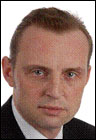A group of European spectrum users and administrators will meet at the offices of the Bundesnetzagentur (Germany’s Federal Network Agency, which regulates telecommunications and RF spectrum in that country) in Mainz, on Apr. 4-5, to discuss the steps that would need to be taken in order to make more ultrahigh-frequency (UHF) spectrum available in Europe for radio frequency identification and other short-range devices (SRDs).
Compared with other regions around the world, Europe has the least amount of UHF spectrum allotted for RFID applications. The European Telecommunications Standards Institute (ETSI) EN 302 208 standard, used in European countries, specifies the 865.6 to 867.6 MHz UHF band for RFID use, and makes provision for a so-called four-channel plan. An unlimited number of readers can operate in each of the four transmit channels, each of which is 200 kHz in width, while the tag responses utilize the other 11 channels available within that band. In the United States, on the other hand, RFID interrogators and tags can use any of 50 different 500 kHz channels residing in the 902 to 928 MHz UHF band.
The meeting will take place amid concerns from some manufacturers and users of short-range devices regarding the proliferation of RFID and potential frequency interference, as well as worries that uncertainty about spectrum could lead to delays in the implementation of RFID applications.
For instance, Bert Moore, a consultant for automatic-identification trade association AIM Global, wrote in an article posted on the organization’s Web site, “Clearly, one concern about the possible allocation of new frequencies is that a considerable amount of money has been spent on research and development of existing RFID systems. Allocation of different frequencies could delay implementations of existing devices because of uncertainty about future regulatory actions and would require significant development costs for new devices.”
At the meeting, attendees—including hardware and software makers, as well as users of RFID technologies—will consider a proposal created for ETSI by individuals in the market for RFID, smart metering and SRDs who seek additional spectrum capacity. ETSI adopted the request, and is asking spectrum regulators at the European level for the 915 to 921 MHz band to be made available for use by the RFID market, and to designate the 870 to 876 MHz band to SRDs and smart metering. The existing UHF RFID spectrum—865.6 to 867.6 MHz—would also remain available for radio frequency identification.
The proposal made to ETSI followed a report published in August 2010 by the European Communications Office (ECO), an agency supporting the European Conference of Postal and Telecommunications Administrations (CEPT), a coordinating body for the telecommunications regulators of 48 European countries. The report, entitled “The Dynamic Evolution of the RFID Market,” indicated that additional RF frequencies may be necessary to improve the functionality of future applications, and to support future market growth. In response, Sergey Pastukh, the chairman of CEPT’s Electronic Communications Committee (ECC) Frequency Management Working Group (WGFM), asked a sub-group, the SRD Maintenance Group, to organize an ECC workshop to examine the need for additional spectrum for RFID and other types of short-range devices.
According to Thomas Weber, the SRD Maintenance Group’s chairman, RFID market players expect to need additional spectrum capacity for deploying new applications, such as an RFID application involving a high number of readers within a confined area. Or they may require the spectrum for higher-performance applications, he adds, such as one that could be used for item-level tagging.
In a formally defined process for assigning spectrum in Europe, the attendees will discuss which studies will need to be performed in order to ensure spectrum compatibility between SRDs and RFID and other wireless devices in the 800 MHz bands, to make sure there is no interference among applications.
“You can only put a new radio application in a frequency after you have made sure it doesn’t interfere with others,” Weber explains, “because there is no empty spectrum. All spectrum is used in some way.”
The affected companies and organizations will also have to make a formal request for studies to be conducted after formally demonstrating the need for additional spectrum through their workshop presentations and speeches. Weber says he expects the meeting to result in a request for the necessary spectrum compatibility studies that would describe the minimum technical requirements to be fulfilled in order to access the spectrum.
The proposed additional spectrum in the 915 to 921 MHz band is officially assigned to Europe’s mobile operators, Weber says, but that the amount of bandwidth is considered inadequate for most mobile applications, such as broadband. As a decision is being considered regarding whether to pursue additional spectrum—and, if so, which studies to conduct—organizations that wish to work with the 915 to 921 MHz band can request a test license or a site-specific license. However, Weber warns, the process of reaching a decision on the spectrum for RFID is complex and includes numerous process steps, involving many individuals in 48 nations.
Thomas Ewers, ECC’s chairman, will speak at the event, and Pastukh will provide an overview of UHF RFID, SRDs and smart metering, and also discuss recent studies on spectrum demand for these technologies in Europe. Additionally, a number of speakers are scheduled to present their views on the justifications for additional spectrum for RFID, including John Falck, the chairman of the EMC and Radio Spectrum Matters Task Group 34 (ERM TG34), which represents the interests of the RFID industry within ETSI, and Christian von Grone, the CIO of Gerry Weber International, a clothing firm that integrates EPC UHF RFID tags into its product-care labels so that items can be tracked from factories to multiple warehouses and on to 200 stores (see Gerry Weber Sews In RFID’s Benefits).
The Bundesnetzagentur meeting is open to European organizations, but is already fully booked up with 140 registrants, which will come mostly from the home-automation, smart-metering and alarm industries. Other attendees will represent the RFID and automotive industries.
After the meeting concludes, the ECC is expected to proceed with the spectrum studies.


